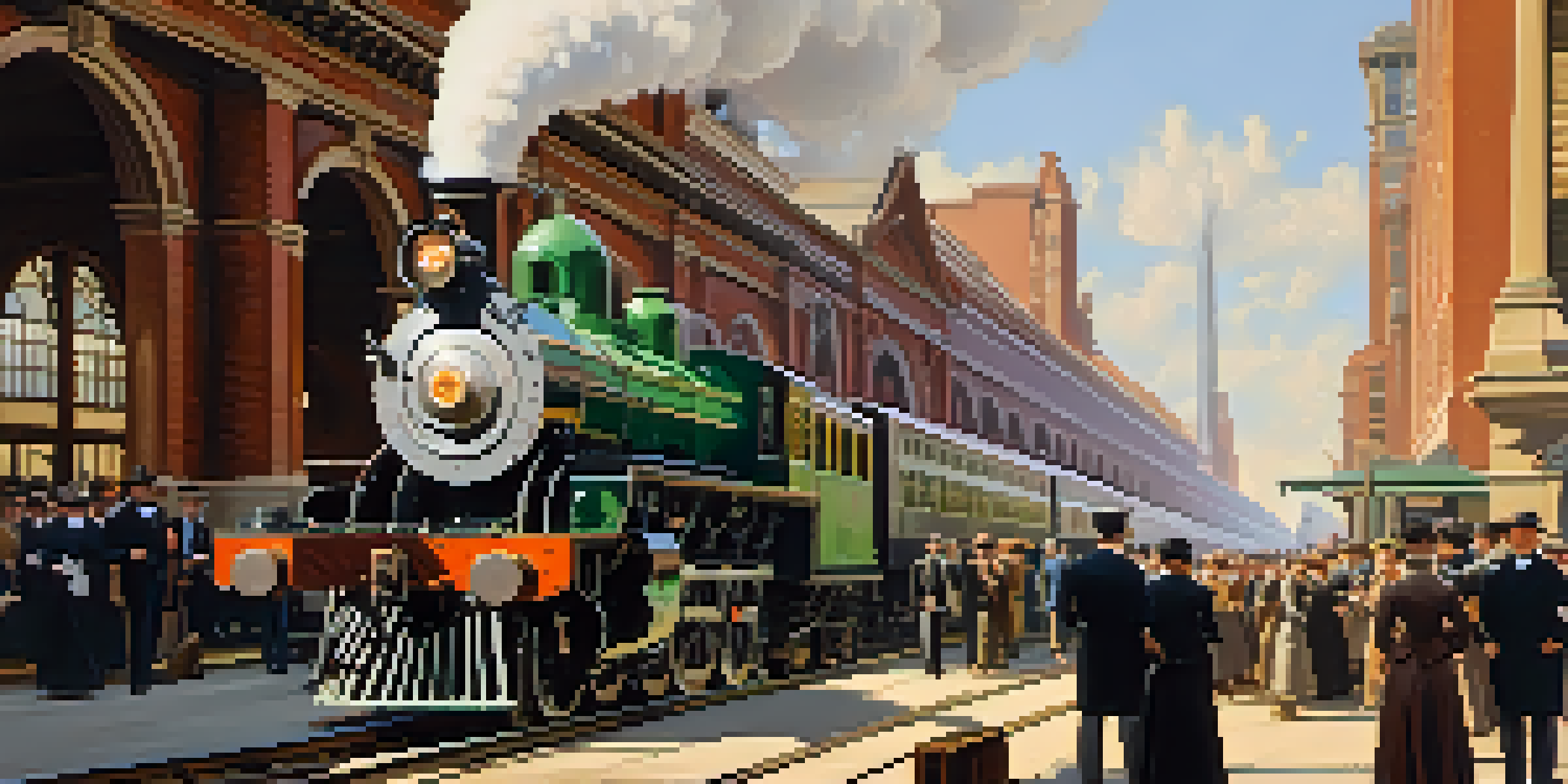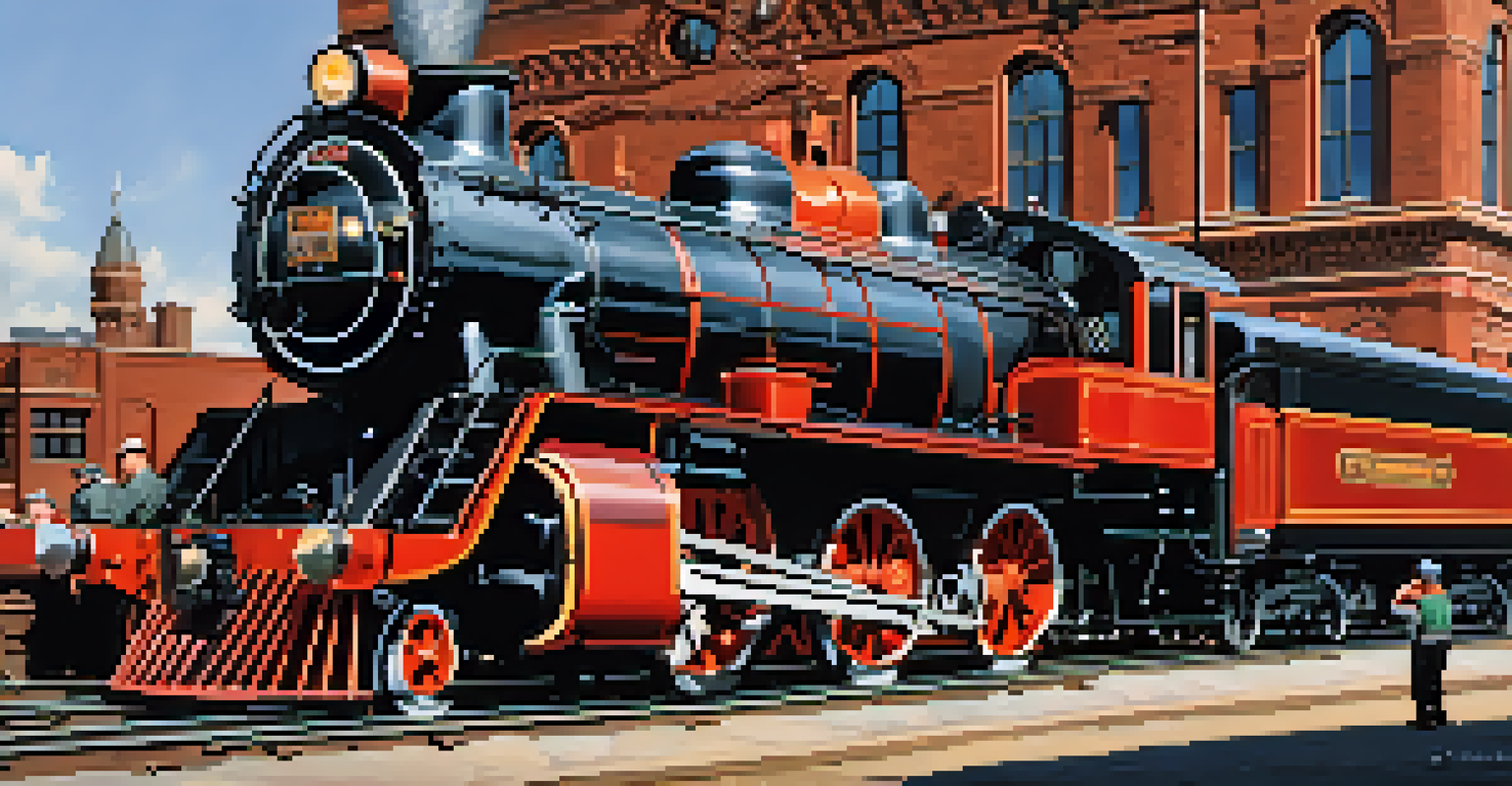The Role of Railroads in Chicago's Economic Expansion

Introduction to Chicago's Railroad Era
The story of Chicago's economic expansion is deeply intertwined with the development of its railroads. In the mid-19th century, Chicago emerged as a critical hub for transportation, linking the East and West. The establishment of extensive rail networks transformed the city into a bustling center of commerce and trade.
The railroads are a great power in the development of the country, and the cities which are connected with them will grow in proportion to the facilities they have for transportation.
Railroads not only facilitated the movement of goods but also attracted businesses and industries seeking access to markets. This influx of commerce created jobs and fostered a diverse economy, laying the groundwork for Chicago's future growth. As more railroads were built, the city’s population boomed, creating a vibrant urban landscape.
Understanding the role of railroads in Chicago's economic history is essential to appreciating how infrastructure can drive urban development. The city’s strategic location made it an ideal point for rail lines, ultimately shaping its identity as a transportation powerhouse.
The Birth of Major Railroads in Chicago
The foundation of Chicago's railroad system began with the Chicago and North Western Railway, established in 1859. This was soon followed by other key players like the Illinois Central Railroad and the Atchison, Topeka and Santa Fe Railway. Each new line contributed to a growing network that connected Chicago to national markets.

These railroads not only improved transportation but also reduced costs for businesses. The ability to move goods quickly and efficiently encouraged manufacturers to set up shop in the city, further diversifying the economy. With each new line, the city became more attractive to both businesses and workers.
Railroads Fueled Economic Growth
The expansion of railroads transformed Chicago into a thriving economic hub by facilitating trade, attracting businesses, and creating jobs.
The competitive nature of the railroad industry also spurred innovation. Companies sought to enhance their services, leading to advancements in technology and logistics that would benefit the economy at large. Railroads became the backbone of Chicago’s economic landscape, shaping its growth for decades to come.
Railroads and Industrial Growth
As railroads expanded, they directly influenced the growth of various industries in Chicago. The meatpacking industry, for instance, thrived due to rail access, allowing companies like Armour and Swift to transport products nationwide. This not only boosted their profits but also created thousands of jobs for local residents.
Transportation is the backbone of any economy, and railroads have historically played a vital role in connecting markets, industries, and people.
Additionally, the ability to ship raw materials efficiently attracted manufacturers of all kinds, from steel to textiles. With easy access to essential resources, businesses could scale up operations and innovate. Railroads effectively turned Chicago into a manufacturing hub, fueling its economic engine.
This industrial growth had a ripple effect on the local economy. More jobs meant increased spending, which stimulated other sectors, such as retail and services. As the city grew, it became a melting pot of cultures and ideas, further enriching its economic landscape.
The Role of Railroads in Trade
Railroads played a pivotal role in enhancing trade, not just locally but on a national and international scale. With access to rail lines, Chicago businesses could easily export their goods to distant markets, strengthening the city’s position as a trade center. This accessibility was key to establishing Chicago as a leader in various industries.
Moreover, railroads facilitated the import of agricultural products from nearby regions. The city became known as the 'Gateway to the West,' allowing farmers to transport their crops to urban markets. This symbiotic relationship between agriculture and industrial growth helped solidify Chicago's economic foundation.
Urban Development Powered by Railroads
Railroads significantly shaped Chicago's urban landscape, leading to the development of neighborhoods and infrastructure improvements.
As trade flourished, so did the city's reputation. Chicago became a bustling marketplace, attracting merchants and entrepreneurs from across the country. The interplay of railroads and trade created a dynamic economic environment that contributed significantly to the city's prosperity.
The Impact on Employment and Migration
As Chicago's railroads expanded, they created a surge in job opportunities, attracting workers from across the nation and beyond. Immigrants flocked to the city, seeking employment in the burgeoning industries that relied on rail transportation. This influx of labor helped populate the city and fueled its rapid growth.
The availability of jobs also led to a diverse workforce, enriching the cultural fabric of Chicago. Workers brought unique skills and perspectives, fostering innovation and collaboration. This diversity became a hallmark of the city, contributing to its dynamic economy.
Moreover, the migration spurred by railroad jobs had lasting effects on neighborhoods and communities. As families settled in Chicago, they established roots, creating a vibrant urban environment that reflected the city's economic vitality. The railroads not only shaped the economy but also the very identity of Chicago.
Railroads and Urban Development
The expansion of railroads in Chicago had a profound impact on urban development. Towns and neighborhoods sprang up around rail depots, transforming the landscape of the city. As railroads connected different areas, they stimulated residential and commercial development, leading to the rise of iconic neighborhoods.
Infrastructure improvements often accompanied railroad expansions, including roads and bridges. These developments improved accessibility, making it easier for residents and businesses to thrive. The layout of Chicago was forever changed, as railroads dictated where people lived and worked.
Challenges of Railroad Expansion
Despite their contributions, the rapid growth of railroads in Chicago brought logistical challenges and required adaptation to new transportation trends.
Additionally, the rise of railroads promoted investment in public services and amenities, enhancing the quality of life for residents. Parks, schools, and cultural institutions emerged, making Chicago an attractive place to live and work. The relationship between railroads and urban development was truly symbiotic, fueling growth on multiple fronts.
Challenges and Adaptations
While railroads significantly contributed to Chicago's economic growth, they also brought challenges. The rapid expansion led to congestion and logistical issues, impacting efficiency. As more trains crisscrossed the city, local leaders faced the task of managing the increased traffic and its effects on urban life.
Moreover, the rise of automobiles and highways in the 20th century posed a new challenge to the railroad industry. As people began to prefer cars for personal travel, railroads had to adapt to changing transportation trends. This shift required innovation and investment to remain competitive.

Despite these challenges, Chicago's railroads have demonstrated resilience. By embracing new technologies and diversifying services, they continue to be a vital component of the city's economy. The ability to adapt has allowed railroads to maintain their significance in a rapidly evolving landscape.
Conclusion: Railroads as Economic Pillars
In conclusion, the role of railroads in Chicago's economic expansion cannot be overstated. They were the driving force behind the city's transformation into a major economic hub. By facilitating trade, supporting industries, and attracting a diverse workforce, railroads laid the foundation for Chicago's growth.
The intertwining of railroads and urban development created a city rich in opportunities and cultural diversity. As Chicago continues to evolve, the legacy of its railroads remains evident in its economic structure and identity. The history of railroads is a testament to the power of infrastructure in shaping the future of a city.
Looking ahead, railroads will play a crucial role in addressing modern transportation challenges. Their ability to adapt to new technologies and sustainability initiatives will ensure they remain relevant in an ever-changing economy. Chicago's future is still closely linked to its railroads, a vital thread in the fabric of its ongoing story.